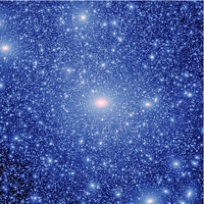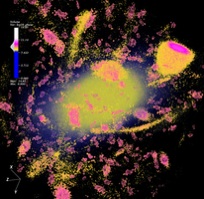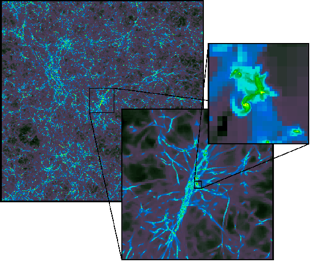Dr. Madau has pioneered many areas that later developed into staples of standard modern cosmology. His tools range from pencil-and-paper to the most ambitious cosmological N-body and hydrodynamical simulations. Below are a few highlights from his body of work:
● In the late 90’s, Madau used new survey data from the Hubble Space Telescope to draw attention to the arc of cosmic star formation. “High-Redshift Galaxies in the Hubble Deep Field: Colour Selection and Star Formation History to z~4” and “The Star Formation Histories of Field Galaxies” were the first papers to tackle this topic in detail and are two of the most highly cited papers in galaxy formation studies. Madau’s diagram of the cosmic-averaged star formation rate versus time has a status in cosmology similar to the HR diagram in stellar evolution, and matching the arc of cosmic star formation has become one of the standard tests of theories of galaxy formation.
● To assemble the cosmic star formation history, Madau had to develop a detailed theory for the absorption of photons by intervening neutral hydrogen between distant galaxies and Earth. The outlines of that theory first appeared in “Radiative Transfer in a Clumpy Universe: The Colors of High-Redshift Galaxies” and was applied to the determination of the cosmic UV background and to the problem of early reionization in “Radiative Transfer in a Clumpy Universe: II. The Ultraviolet Extragalactic Background”. These calculations were instrumental in developing accurate selection criteria for high-redshift galaxies in imaging surveys by their broadband colors (the “Lyman Dropout” technique) and in converting these colors into meaningful redshifts. The dropout technique has since been extended to redshift z~9 and is now our principle means of locating and studying infant galaxies.
● The reionization of the all-pervading intergalactic medium is a landmark event in the history of cosmological structure formation, and Madau and collaborators were the first to offer a new observational diagnostic of this era. They realized that the details of the process might actually be observable through radio-astronomical measurements of spectral and spatial structure in 21-cm line emission from large-scale structure at high redshifts. The resulting papers “21 Centimeter Tomography of the Intergalactic Medium at High Redshift”, “Radio Signatures of HI at High Redshift: Mapping the End of the Dark Ages”, and “Can the Reionization Epoch Be Detected as a Global Signature in the Cosmic Background?” were the first to describe quantitatively how patchiness in the 21-cm emission signal as a function of frequency and spatial scales may be used to map the end of the dark ages, i.e., the transition from the post-recombination universe to one populated with radiation sources. They became an icon for the wave of many long-wavelength 21-cm radio telescopes now being built around the world (e.g., PAPER, LOFAR, MWA, SKA).
● Dr. Madau has also been a pioneer in the study of the formation and the growth of the massive black holes (MBHs) that reside at the centers of galaxies, of how they become incorporated through a series of mergers into larger and larger halos, sink to the center owing to dynamical friction, accrete a fraction of the gas in the merger remnant to become supermassive, form a binary system, and eventually coalesce. A widely cited paper, “The Assembly and Merging History of Supermassive Black Holes in Hierarchical Models of Galaxy Formation” was one of the first to follow the assembly of MBHs via hierarchical merging. A noteworthy prediction of this paper is that a large fraction of MBHs should be binaries, and the study of such objects has become a growing industry. This paper presumed a pre-existing seed population of black holes formed early in the universe as the end-product of pregalactic star formation, following early ideas developed in “Massive Black Holes as Population III Remnants”.
● The latest major chapter in Madau’s research is his entry into large and highly sophisticated “zoom-in” simulations of Milky Way-sized galaxies. In the current paradigm of cosmic structure formation, such galaxies are embedded within extended halos of dark matter, which form through the gravitationally-induced aggregation of many smaller progenitors. The merging of these fragments is rather inefficient, and leaves substantial amounts of “substructure'' orbiting the host. When completed in 2008, the one-billion particle Via Lactea II N-body simulation, “Clumps and Streams in the Local Dark Matter Distribution”, was the highest resolution dark-matter simulation of the Milky Way halo yet computed, by a wide margin, a tour de force that is viewed as one of the landmark study in the field. The Via Lactea II simulation was featured as one of the "Top Ten Breakthroughs in Computational Science" in the 2009 DOE's Office of Advanced Scientific Computing Research Report. It showed for the first time the existence of thousands of very concentrated dark matter clumps surviving within the inner 50 kpc from the Galactic Center, and has become the benchmark against which the deficit of visible satellites (the “missing satellite problem”) is routinely compared. More recently, in “Forming Realistic Late-Type Spirals in a ΛCDM Universe: The Eris Simulation”, Madau and collaborators have added gas physics and star formation to show, again for the first time in a cosmological ΛCDM simulation of extreme dynamic range, how it is possible to form a fully realistic Milky Way galaxy with the right rotation curve and bulge-to-disk ratio.




